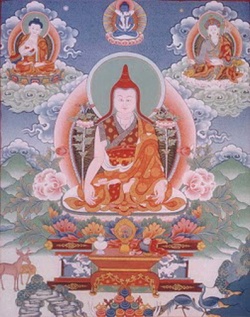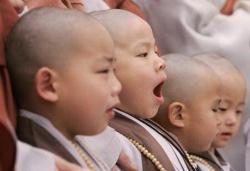Sahampati
A Mahābrahmā.
When the Buddha was at the Ajapālanigrodha, hesitating as to whether or not he should preach the Dhamma, Sahampati appeared before him and begged of him to open to the world the doors of Immortality. The Buddha agreed to this urgent request (Vin.i.5f.;S.i.137f), and accepted from Sahampati the assurance that all the Buddhas of the past had also had no other teacher than the Dhamma discovered by them. S.i.139; see also S.v.167f.,185, 232, where he gives the same assurance to the Buddha regarding the four satipatthānas and the five indriyas; A.ii.10f.
Buddhaghosa (E.g., SA.i.155) explains that the Buddha was reluctant to preach, not on account of indolence, but because he wished Sahampati to make him this request. For, thought the Buddha, the world honours Brahmā greatly, and when people realized that Brahmā himself had begged of the Buddha to spread his teaching, they would pay more attention to it. Sahampati was, at this time, the most senior of the Brahmās (jettha-Mahābrahmā) (DA.ii.467).
Sahampati once saw that the brahmine, mother of Brahmadeva Thera, habitually made offerings to Brahmā. Out of compassion for her, Sahampati appeared before her and exhorted her to give her offerings to Brahmadeva instead (S.i.140f). On another occasion, when Kokāliya died and was born in Padumaniraya, Sahampati appeared before the Buddha and announced the fact to him (SN. p.125; cp. S.i.151; A.v.172).
The Samyutta (S.i.154f) contains a series of verses spoken by Sahampati at Andhakavinda, when the Buddha sat out in the open during the night and rain fell drop by drop. The verses are in praise of the life and practices of the monks and of the results thereof. Sahampati again visited the Buddha, simultaneously with Sakka, and as they stood leaning against a doorpost of the Buddha's cell, Sakka uttered a verse in praise of the Buddha. Sahampati then added another verse, exhorting the Buddha to preach the Doctrine, as there were those who would understand (S.i.233). A verse spoken by him immediately after the Buddha's death is included in the books (D.ii.157; S.i.158).
During the time of Kassapa Buddha, Sahampati was a monk, named Sahaka, who, having practised the five indriyas (saddhā, etc.), was reborn in the Brahma world. Thereafter he was called Sahampati (S.v.233). The Commentaries say (SNA.ii.476; SA.i.155) that he was an Anāgāmī Brahmā born in the Suddhāvāsā, there to pass a whole kappa, because he had developed the first Jhāna as a monk. The Buddhavamsa Commentary (BuA.p.11; see also p.29) says that, strictly speaking, his name should be "Sahakapati." When the Buddha attained Enlightenment, Sahampati held over the Buddha's head a white parasol three yojanas in diameter. BuA.239; this incident was sculptured in the Relic Chamber of the Mahā Thūpa (Mhv.xxx.74); cp. J.iv.266.
Once he offered to the Buddha a chain of jewels (ratanadāma) as large as Sineru (KhA.171; Sp.i.115; Vsm.201). On the day that Alindakavāsi Mahāphussadeva attained arahantship, Sahampati came to wait upon him (VibhA.352).
It has been suggested (VT.i.86, n.1) that Brahmā Sahampati is very probably connected with Brahmi Svayambhū of brahmanical literature.
Source
www.palikanon.com [[Category:]]

